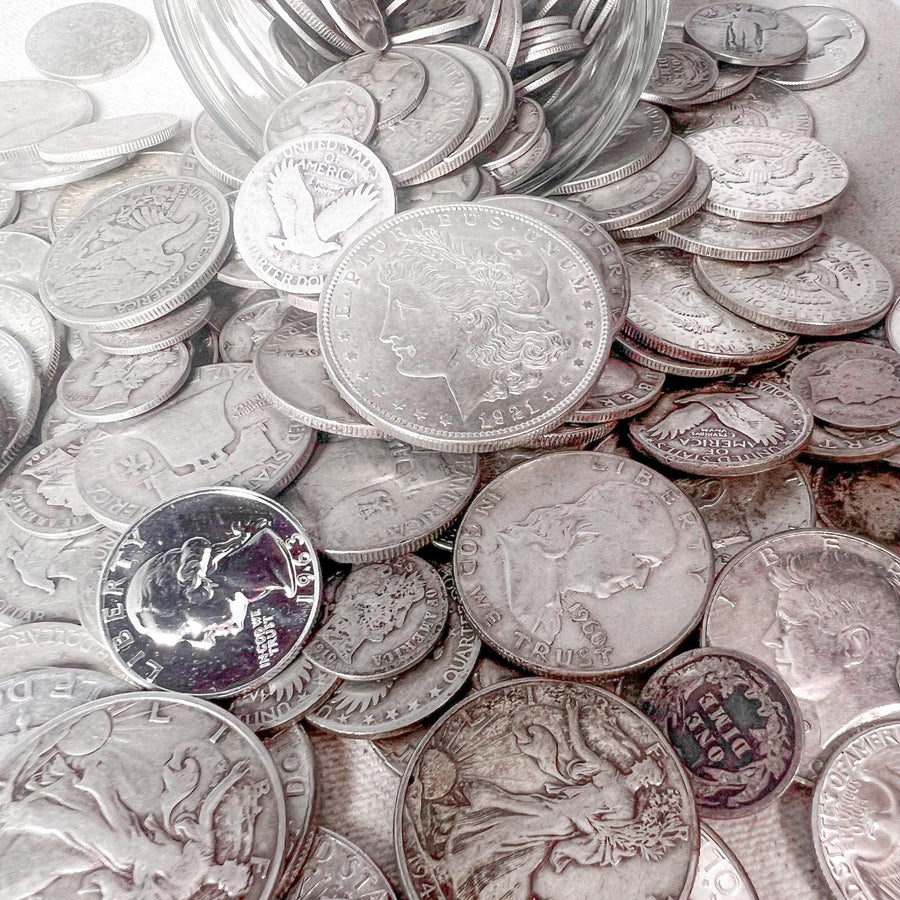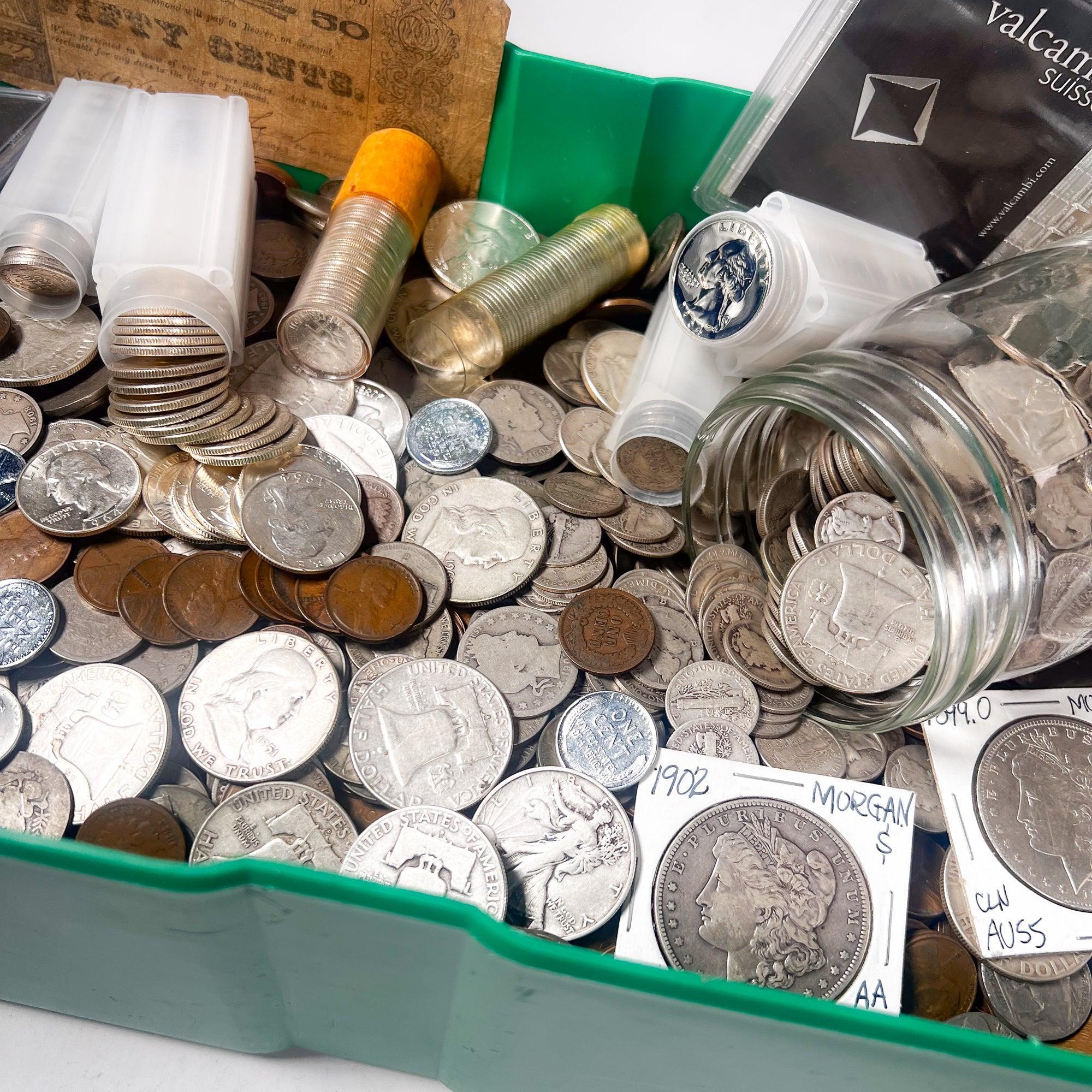Unlock Hidden Value: Strategic Investing in 90% Silver U.S. Coins for Numismatic Gains
Are you missing the true potential of your 90% silver coins? Often dismissed as "junk silver" for their bullion value, these coins can be far more than a hedge against inflation. With the right knowledge, you can transform them into highly profitable assets by tapping into their numismatic value.
This guide, Unlock Hidden Value: Strategic Investing in 90% Silver U.S. Coins for Numismatic Gains, reveals how to identify and acquire coins with significant collectible worth, leveraging rarity, condition, and market demand to maximize returns. Let’s dive into the world of numismatics and elevate your investment strategy!
The Foundation: What Are 90% Silver U.S. Coins?
Before unlocking their hidden value, it’s essential to understand the historical significance of 90% silver U.S. coins. Minted before 1965, these dimes, quarters, and half dollars contain 90% silver and 10% copper. Rising silver prices led to the Coinage Act of 1965, which shifted U.S. coinage to copper-nickel clad, ending the era of silver circulation.
Common 90% Silver Coin Series:
-
Roosevelt Dimes (1946–1964): The final silver dimes, widely collected.
-
Washington Quarters (1932–1964): A staple of "junk silver" with numismatic potential in early dates.
-
Kennedy Half Dollars (1964 only): The only 90% silver year for this iconic coin.
-
Mercury Dimes (1916–1945): Known for their stunning design and key dates.
-
Standing Liberty Quarters (1916–1930): Prized for their artistry and rarity.
-
Walking Liberty Half Dollars (1916–1947): Iconic and highly collectible.
-
Franklin Half Dollars (1948–1963): Popular for their bold design and proof issues.
While often bought in bulk for their silver content (approximately 0.715 troy ounces per $1.00 face value), these coins hold untapped numismatic potential that can far exceed their melt value.
Melt Value vs. Numismatic Value: The Key to Profit
To maximize returns, you must distinguish between melt value (the coin’s silver worth) and numismatic value (its collectible worth). Confusing these can mean missing out on significant profits.
Melt Value: The Baseline
Melt value is the coin’s worth based on its silver content and the current spot price. For example:
-
Dime: 0.0723 troy oz x $28.00/oz spot price = $2.02
-
Quarter: 0.1808 troy oz x $28.00/oz = $5.06
-
Half Dollar: 0.3617 troy oz x $28.00/oz = $10.13
This value fluctuates with silver prices, influenced by global supply, demand, and economic factors. While a secure floor, it’s not the ceiling for value.
Numismatic Value: The Profit Driver
Numismatic value reflects a coin’s worth to collectors, driven by:
-
Rarity: Low mintage or surviving examples.
-
Condition: Preservation and lack of wear.
-
Historical Significance: Ties to specific eras or events.
-
Aesthetic Appeal: Design beauty and strike quality.
-
Market Demand: Collector interest and trends.
For example, a 1964 Washington Quarter might sell near its melt value in circulated condition, but a rare 1932-D in Fine-12 could fetch hundreds, and in MS-65, thousands—far beyond its silver content.
Pillars of Numismatic Value: Rarity, Condition, Demand
To unlock numismatic gains, focus on three key pillars:
Rarity: The Scarcity Factor
Rarity drives value through:
-
Low Mintage: Coins like the 1916-D Mercury Dime (264,000 minted) are inherently scarce.
-
Survival Rates: Many coins were lost or melted, reducing available examples.
-
Key Dates & Varieties:
-
1916-D Mercury Dime: A low-mintage gem.
-
1932-D/S Washington Quarters: Early-year rarities.
-
1942/1 Mercury Dime Overdate: A visible error boosting value.
-
Errors: Off-center strikes or doubled dies (e.g., 1937 Washington Quarter DDR).
-
Condition: The Grade Matters
Condition, assessed on the Sheldon Scale (1–70), can exponentially increase value. A 1916-D Mercury Dime in Good-4 might fetch thousands, but in MS-65 Full Bands, it could exceed $100,000. Key factors:
-
Originality: Untouched surfaces are prized.
-
Toning: Natural patina adds appeal.
-
Luster & Strike: Sharp details and mint sheen boost value.
-
Avoid Damage: Cleaning, scratches, or PVC residue drastically reduce worth.
Market Demand: The Collector’s Pulse
Demand varies by series and trends:
-
Iconic Designs: Walking Liberty Halves and Mercury Dimes are perennial favorites.
-
Economic Conditions: Strong economies boost collector spending.
-
Trends: New collectors can revive interest in older series.
Track demand via auction results, dealer inventories, and NGC or PCGS population reports.
Visual Assessment: Your First Step
Before investing, develop basic inspection skills to spot valuable coins:
-
Tools: Use a 5x–10x loupe, LED light, and cotton gloves.
-
Key Areas:
-
Date & Mintmark: Ensure clarity.
-
Design Details: Check high points (e.g., Liberty’s head on Standing Liberty Quarters).
-
Fields & Rims: Look for scratches or bag marks.
-
-
Avoid Damage: Watch for cleaning lines, chemical residue, or weak strikes mistaken for wear.
-
Varieties: Spot doubled dies or overdates with magnification.
This skill helps you avoid overpaying for damaged or over-graded coins.
Professional Grading: Unlocking Full Value
For high-value coins, professional grading by NGC or PCGS is essential:
-
Process: Coins are graded on the Sheldon Scale, encapsulated in tamper-evident slabs, and assigned a certification number.
-
CAC Validation: A green or gold CAC sticker signals superior quality for the grade.
-
Benefits:
-
Authenticity guarantee.
-
Standardized condition assessment.
-
Enhanced liquidity and marketability.
-
-
Costs: Vary by coin value and service level, with turnarounds from weeks to months.
Grading is cost-effective only for rare or high-grade coins, not common junk silver.
High-Potential Coins to Target
Focus on these series and attributes for numismatic gains:
Mercury Dimes (1916–1945)
-
Key Dates: 1916-D, 1921, 1921-D, 1942/1, 1942/1-D.
-
Full Bands (FB): Clear separation of fasces bands in uncirculated coins.
Standing Liberty Quarters (1916–1930)
-
Key Dates: 1916, 1917 Type 1, 1918/7-S.
-
Full Head (FH): Sharp helmet and hair details.
Washington Quarters (1932–1964)
-
Key Dates: 1932-D, 1932-S.
-
Varieties: 1937 DDR, 1943 DDO.
Walking Liberty Half Dollars (1916–1947)
-
Key Dates: 1916-S, 1921, 1921-D.
-
Full Strike: Detailed hand, drapery, and eagle feathers.
Franklin Half Dollars (1948–1963)
-
Full Bell Lines (FBL): Unbroken lines on the Liberty Bell.
-
Proof Issues: Highly collectible for their mirror-like finish.
Roosevelt Dimes & Kennedy Half Dollars
-
High-Grade Examples: MS-65+ coins with vibrant luster.
-
1964 Kennedy: The only 90% silver year, prized in high grades.
Strategic Acquisition & Portfolio Management
Build a profitable portfolio with these tips:
-
Acquisition Channels:
-
Online Dealers: Try Midwest Precious Metals Exchange for certified coins.
-
Local Shops: Build relationships for expert advice.
-
Coin Shows & Auctions: Find rare pieces at Heritage Auctions or Stack’s Bowers.
-
-
Due Diligence: Check seller reviews, return policies, and affiliations with ANA or ICTA.
-
Diversify: Mix key dates, high-grade commons, and different series.
-
Risk Management: Buy graded coins to avoid fakes and monitor market cycles.
Cashing In: Maximizing Returns
When selling, choose the right channel:
-
Online Auctions (e.g., eBay): Ideal for mid-range coins; use high-quality photos.
-
Numismatic Auction Houses: Best for rare, graded coins.
-
Dealers: Sell outright for speed or consign for higher returns.
-
Private Sales: Riskier but commission-free.
Best Practices:
-
Provide accurate descriptions and clear images.
-
Research recent sales for realistic pricing.
-
Time sales during high-demand periods.
Considerations: Store coins in archival holders, secure numismatic insurance, and consult a tax professional for capital gains implications.
The Investor’s Mindset: Patience & Passion
Success in numismatic investing requires:
-
Continuous Learning: Study NGC population reports, price guides, and forums like CoinTalk.
-
Networking: Join coin clubs or connect with dealers.
-
Passion: Enjoy the history and artistry of each coin.
-
Long-Term Perspective: Rare coins often appreciate over decades.
Ready to unlock the hidden value of 90% silver U.S. coins? Start with trusted sources like Midwest Precious Metals Exchange for NGC-certified coins and build a portfolio that blends financial savvy with numismatic passion. Your journey to profitable collecting begins now!
Disclaimer: Consult a financial advisor before investing. Numismatic values and silver prices are subject to market fluctuations.












